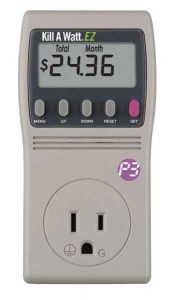Tag Archives: vampire
ELECTRICITY VAMPIRE MONITOR.
 Energy vampires are electrical devices that consume electricity when they are turned off. Everyone has them. Your home is using electricity 24 hours a day, whether you are home or away. Most energy vampires use electricity to receive a signal, like from a remote controller; or they have a clock, timer, and sensor inside them that is always running. I think that a lot of people would unplug the infrequently used gadgets in their homes if they knew just how much it was costing them to leave them plugged in. Some small electrical devices use a surprisingly large amount of electricity when they are turned off. For example, an Xbox One consumes over 100 watts of electricity an hour while it is turned off. That is because it is always in standby mode, which means that it is using electricity so it can receive a signal from a remote controller. It can cost you $50 a year to keep an Xbox One or Playstation plugged in, even if its just gathering dust and nobody ever uses it. Larger energy vampires can burn up a lot more than $50 a year. Some plasma TVs consume over $150 in electricity per year while they are turned off. There are also a lot of small electrical gadgets that you might not think of as energy vampires at all, but that actually are. For example, many coffee makers use electricity while they are turned off. If you have a coffee maker that is programmable or that has a clock in it, it is using electricity while it is turned off. Even if you never make coffee at home, a programmable coffee maker will cost you about $15 a year in wasted electricity just because you left it plugged in. Many other small appliances that you might not think of energy vampires actually do use electricity while they are turned off, including toasters, blenders, hair dryers, and electric toothbrushes.
Energy vampires are electrical devices that consume electricity when they are turned off. Everyone has them. Your home is using electricity 24 hours a day, whether you are home or away. Most energy vampires use electricity to receive a signal, like from a remote controller; or they have a clock, timer, and sensor inside them that is always running. I think that a lot of people would unplug the infrequently used gadgets in their homes if they knew just how much it was costing them to leave them plugged in. Some small electrical devices use a surprisingly large amount of electricity when they are turned off. For example, an Xbox One consumes over 100 watts of electricity an hour while it is turned off. That is because it is always in standby mode, which means that it is using electricity so it can receive a signal from a remote controller. It can cost you $50 a year to keep an Xbox One or Playstation plugged in, even if its just gathering dust and nobody ever uses it. Larger energy vampires can burn up a lot more than $50 a year. Some plasma TVs consume over $150 in electricity per year while they are turned off. There are also a lot of small electrical gadgets that you might not think of as energy vampires at all, but that actually are. For example, many coffee makers use electricity while they are turned off. If you have a coffee maker that is programmable or that has a clock in it, it is using electricity while it is turned off. Even if you never make coffee at home, a programmable coffee maker will cost you about $15 a year in wasted electricity just because you left it plugged in. Many other small appliances that you might not think of energy vampires actually do use electricity while they are turned off, including toasters, blenders, hair dryers, and electric toothbrushes.
Kill-A-Watt Monitor. If you would like to know just how much electricity your household gadgets and appliances are using while they turned off as well as on, I have a Kill-A-Watt electricity monitor that you can borrow. This monitor is very easy to use. It was designed at the Lawrence Berkeley Lab. The Kill-A-Watt monitor shows you just how much every electrical device in your home costs you by the day, month, and year. You might be surprised by just how much some infrequently used electrical gadgets cost you. The Berkeley Lab estimates that between 5% and 10% of all the electricity consumed by average the U.S. home is used by energy vampires. The Department of Energy estimates that energy vampires cost American consumers $20 billion a year.
